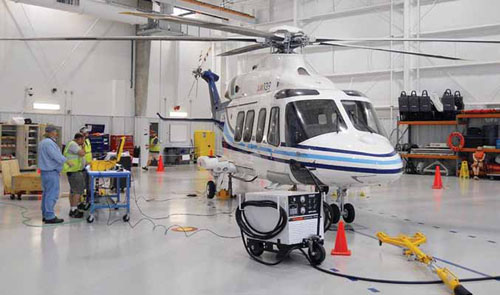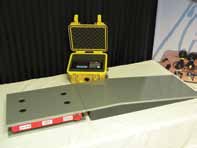
Helicopter Weighing 101 – Benefits and Pit Falls


Larry Jackson – Contributing Author
Helicopters are special machines. The maintenance professionals who work on them are also special. We are a fussy bunch when it comes to maintenance and with good reason. Fixed-wing aircraft can’t hover! When it comes to maintenance, in particular weighing operations to determine airworthiness, we have to consider the sensitive nature of the beast.
Helicopters are a lot more critical than their fixed-wing counter parts when it comes to weight and balance, mainly due to their centroid nature, hanging under a mast fixed to the rotor blades. The fore and aft center of gravity (CG) has less range than standard aircraft and more attention to lateral CG can come into play as well.
Benefits of Weighing
Conducting an actual weighing can be a critical benefit to maintenance. Instead of adding or subtracting from someone else’s figures and numbers, actual weighing takes the “not really knowing” out of the equation. Part 135 operators are required to weigh the helicopter every three years. This pretty much removes any doubt about the helicopter’s actual weight, but what about helicopters that don’t require re-weighing?
Some aircraft go about their business, get modified, painted and have STCs incorporated, have avionics upgrades and so on, but never get weighed after the work is done. When determining airworthiness and releasing one of these aircraft to flight status, knowing the aircraft’s true weight is a must, as in all probability it now has a different basic empty weight (BEW) as well as a new basic operating weight (BOW). This will affect payload, range, etc.
Many times when aircraft get weighed, they weigh more than the paper work says. EMS, law enforcement and Part 135 operators, as well as the corporate operator, need to have the actual BEW determined properly in order to determine the BOW for proper operations, and to ensure safety margins from the manufacturer are still met.
Weighing a helicopter prior to and after heavy maintenance modifications can save hours of time, i.e., time figuring out the weight of everything going into or out of the helicopter, and time spent explaining to the operator why their helicopter now weighs more or in some cases less. If it weighs more going in then was thought, that now becomes a known number to work with, which helps in the overall quality of the job.
Pitfalls of Weighing
The biggest problem we encounter is not accounting for everything on the helicopter and or changes not recorded or considered, and that of course impacts the overall weight. It is imperative that the equipment list Chart A is verified and the helicopter is inventoried. Check the helicopter’s Chart C and modification records to ensure that all is in order and the configuration is correct when weighing. Follow the manufacturer’s instructions completely when performing a configuration check.
Defueling properly is also a big issue. Regardless if the helicopter has wheels or skids, always defuel in a level condition to insure trapped fuel is not lingering in the tank areas. Hydraulic levels should be checked, and if there is liquid oxygen (LOX) on-board, determine that the tank is serviced properly and at the level required by the operator.
Another area we must pay attention to is using the right scale for the job. We would not use a 100 foot-pound torque wrench on a 15 inch-pound nut, so why would we use a 150,000-pound scale for a large fixed-wing aircraft to weigh our 4,000-pound helicopter? The right size scale and calibrated range, as well as readout resolution, should always be considered.
My Helicopter Weighs Too Much
OK, we have done everything on the checklist and have a quality scale in the right range, but we come out heavy. Some things to consider are:
• Was the aircraft painted but not stripped? Any logbook entry for weight and balance after the event? Today, HVLP spray guns put almost all the paint on the aircraft. Thus it weighs more.
• Was the aircraft weighed with LOX not serviced before, as well as other items installed not accounted for?
• Perhaps the aircraft was weighed coming out of major maintenance on the fuel system. Was all the usable undrainable or unusable undrainable added back in to the numbers?
• Were skid snow shoes or soft surface plates installed during winter ops, but not accounted for in the summer when weighed?
• Hoist or hook installation? Was the aircraft weighed after adding those systems or just paper calculated?
• Life vests or pop outs on or off? Did the equipment type manufacturer get changed to another manufacturer type that weighs more between weighing?
These are just some of the weight issues we have encountered. The point being made is that with a properly-calibrated scale and a proper configuration, we will see the actual weight we are dealing with. We can take that number and now start to figure out what changed and make corrections accordingly.
Heavy Modifications
When a helicopter is being considered for a modification, many times the helicopter’s weight is a selling point. “Our equipment weighs less than what the factory installed,” so you will pick up 60 pounds in payload! Sometimes this is true, but did the company doing the mod remove all the wiring of the old system or just stow the connectors and run new wiring, leaving the weight on the bird?
EMS, law enforcement and military ships most often are the largest weight gainers, but watch out for corporate and offshore ships as well. Many times interiors are changed and additional equipment and new avionics are added along with their wiring and plumbing. If you have scales, you are afforded the chance to weigh before and sometimes during, and it’s a must after modifications. This can be critical to your operation if you are payload and weight sensitive in your operation. If you’re going to a shop to have the work done, ask them if they have scales and make that part of your specification work package to conduct weighings at critical points in the process. Always inspect their scales and ensure that they have the proper scale in place. Many times we have seen a large scale used for a smaller ship, only to yield a wrong unwanted number. Take that number and start adding equipment and your actual figures may be right, but your actual weight may be wrong.
Scale Selection
In general, it is recommended that a 5,000-pound per cell top of jack kit, or platform be used counting in a one-pound count for small to medium helicopters. Ensure that the calibration certificate has a documented lower limit that is lower than our lightest weight and has test points throughout your weight range. For large aircraft, a 10,000-pound per cell or platform kit counting in a one-pound count should be used with the same requirements as above for certification.


Always know where the scale was calibrated, the qualifications of the technician that did the job, and that the calibration was done in accordance with the manufacturer’s specifications. Many times a quality cal lab for torque wrenches, meters and gauges might be used, but are they trained in the proper calibration procedures for the scale? Do they have the proper instructions? Aircraft scales are not the same as a normal scale in regard to tolerance. Aircraft scales require a 1/10th of one percent or three indicator division tolerance. Regular scales may only require a one percent tolerance so the shop may say your 5,000-pound cell is good when it may not meet the aviation requirement. If in doubt, always send your scale back to the manufacturer or an aviation specific calibration knowledgeable shop. Ask, audit and make sure they have National Institute of Standards and Technology (NIST) traceable standards and master standards only used for aviation scale calibrations.
Application
OK, I have a good scale, calibrated to NIST traceable standards and I’m ready to go. Consider your climate, hangar conditions and application, particularly top of jack cell units. Always let your scale come up or down to temperature to match the hangar conditions. This may require a couple of hours if coming from a cold stock room to a hot hangar or a warm stock room going into a cold hangar.
Consider if the floor is level. Remember, most floors have drains and the level of the floor runs towards them. Check the jack cylinders for vertical level in both axis fore and aft as well as lateral. Shims may be required to level the jacks prior to actual weighing and leveling of the helicopter. This will prevent side loading and cocking.
We should always know our target number. Look at the last weighing sheet recorded and then determine what the aircraft’s weight should be. If we get a large change that can’t be accounted for, then we need to consider our application and jacking or the load cells for proper reading. If need be, we should rotate the cells from point to point and determine if we have a cell problem or if a point really is heavy or light. If the problem is confirmed that the cell is in error, tag that cell and record the weight range at which the error occurred. This will help the calibration shop in testing and repairing as well as confirming our problem.
We should always lead or lag the dampers and use the proper special tool if instructed to do so, or weigh with the blades off for an accurate reading. Clock angle of the main rotor must also be checked. Most require the master blade to be positioned over the tail boom or a specific blade configuration.
Weighing is a precise operation. The scale is a sensitive piece of calibrated equipment, and your approach and understanding to the job is what makes you a helicopter maintenance specialist. You are special and so is your machine. As professionals, airworthiness is our job and safety should never be compromised!
 Jackson is an A&P, IA and pilot. The companies manufacture, repair and calibrate aircraft and helicopter scales with NIST traceability. The Web sites aircraftscales.com and helicopterscales.com are divisions of Jackson Aircraft Weighing Service.
Jackson is an A&P, IA and pilot. The companies manufacture, repair and calibrate aircraft and helicopter scales with NIST traceability. The Web sites aircraftscales.com and helicopterscales.com are divisions of Jackson Aircraft Weighing Service.
